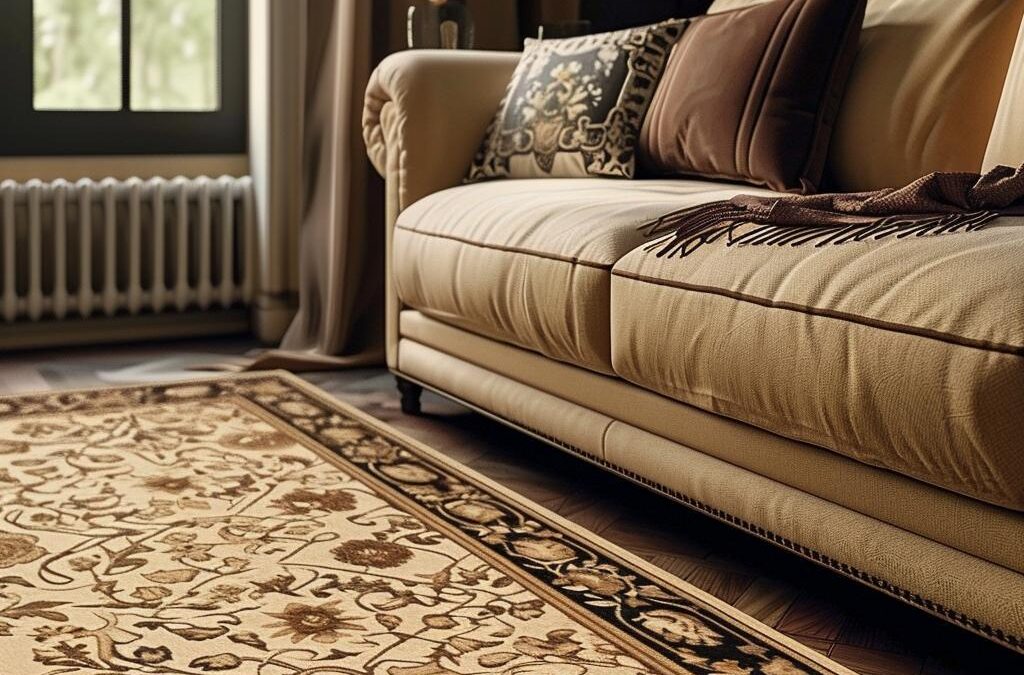Rugs are the quiet heroes of interior design. They ground our furniture, inject warmth and texture into a room, and absorb the noise and chaos of daily life. They are, in essence, functional works of art. However, this functional role—especially in high-traffic areas—exposes them to relentless wear. The common mistake is to treat a rug as a static element of décor when, in reality, it is a dynamic filtration system that actively traps everything from airborne pollutants to microscopic grit.
This guide goes beyond surface-level cleaning. We will delve into the science of rug degradation, differentiate between various care needs based on fiber type, and establish a robust, systematic approach to maintenance that not only enhances the rug’s immediate appearance but fundamentally preserves its structural integrity and investment value for decades.
The Invisible Enemy—Understanding Rug Contamination and Degradation
To properly care for your rug, you must understand the subtle, cumulative forces that work against its longevity. Degradation is rarely sudden; it is a slow, insidious process driven by three main factors.
The Abrasive Grit and Soil
The most damaging element to any rug is the dry particulate matter: sand, fine dirt, and minute sharp soil tracked in from outside.
- The Sandpaper Effect: When you walk across a rug, the weight of your body, combined with the presence of sharp, embedded grit, causes the rug fibers to rub against the abrasive particles. This process, known as the “sandpaper effect,” slowly and microscopically slices the wool, silk, or synthetic fibers. Over time, this mechanical abrasion leads to a thinning of the pile and a premature loss of the rug’s original plushness and density.
- Dulling of Luster: Embedded fine dust creates a cloudy layer that scatters light instead of reflecting it. This makes the rug’s colors appear muted, dull, and far less vibrant than they were when new.
Microscopic Biological Hazards
A rug is an ecosystem for a variety of unwelcome microscopic residents that pose a direct threat to indoor air quality and fiber health.
- Allergens and Mites: Rug fibers are the perfect habitat for dust mites. These mites shed waste and decomposition products that are potent allergens, triggering asthma and rhinitis. Regular deep cleaning is the only way to significantly reduce this allergen load.
- Mold and Mildew: In humid environments, or after spills that are not quickly and completely dried, moisture trapped in the backing or deep within natural fibers (like jute or cotton foundation yarns) can lead to mold and mildew growth. This is characterized by a musty, persistent odor and can structurally compromise the rug’s foundation.
- Pet Contamination: Pet dander, oils, and the challenging uric acid crystals from urine stains are embedded deep into the foundation. These compounds attract bacteria and resist simple water-based cleaning, leading to chronic odor issues.
Chemical and Light Damage
Chemical degradation can occur from incorrect cleaning products, while solar exposure causes physical damage.
- Harsh Cleaners: Using generic carpet or household cleaners with high pH (alkalinity) on delicate fibers, especially wool, can strip the fiber’s natural lanolin layer and cause permanent discoloration or “browning” by disrupting the dye bonds.
- UV Fading: Direct, prolonged exposure to ultraviolet (UV) light causes photo-degradation. This results in the fading of dyes, an effect that is often uneven and irreversible, visibly diminishing the rug’s aesthetic value.
Timely Intervention—Signs Your Rug Demands Attention
Ignoring the subtle cues your rug gives you can turn a reversible cleaning issue into permanent damage. Vigilance is key to maintaining your investment.
- Visible Color Dullness: Dry soil and oils have created an opaque film over the fibers, scattering light. This requires washing and extraction to restore fiber clarity and reflectivity.
- The “Snap” Test: Lift a corner of your rug and quickly snap it against the floor. If a cloud of dust is expelled, the rug is saturated with embedded dry soil. This necessitates immediate professional dusting and deep washing to remove abrasive grit.
- Unpleasant Odors: Indicates bacteria, mold, mildew, or the reactivation of uric acid crystals within the damp foundation. This requires specialized decontamination treatments (e.g., enzymes, sanitizers) and controlled drying.
- Texture Change/Gritty Feel: The pile feels rough, stiff, or less resilient underfoot. This signals massive particle entrapment accelerating the sandpaper effect. This requires immediate deep washing to remove abrasive particles and reduce fiber damage.
- Yellowing or Browning: Often seen in areas where a spill dried slowly, this can be dye migration or cellulosic browning (oxidation of plant fibers). This requires specialized chemical treatment and controlled rinsing to neutralize and correct discoloration.
The Multi-Tiered Approach to Rug Maintenance
Effective rug care is a holistic system, not a single action. It involves a daily, weekly, and annual strategy tailored to the rug’s use and fiber type.
Foundational Daily and Weekly Care
This maintenance focuses on removing surface soil before it can become embedded grit.
- Frequency and Technique: Vacuum high-traffic areas 2–3 times per week and low-traffic areas weekly.
- High-Pile/Shag: Use a suction-only vacuum or a handheld attachment without a rotating beater bar, which can snag and pull long fibers.
- Low-Pile/Traditional: A vacuum with an adjustable-height beater bar is acceptable, but ensure the setting is high enough to agitate the dirt without damaging the fibers.
- The Back Side: Once or twice a year, flip the rug and vacuum the back side. This process uses vibration to dislodge deeply embedded grit up to the surface where it can be vacuumed away.
- Immediate Spot Cleaning: Always follow the rule: Blot, never rub. Rubbing causes the spill to spread and pushes the contaminant deep into the foundation. Use a clean, white absorbent towel. Treat the stain using a mild solution (e.g., pH-neutral dish soap and cool water) applied to a cloth, gently dabbing from the edges inward.
The Annual Deep Cleaning Imperative
No amount of vacuuming can remove the embedded, abrasive soil and biological waste trapped deep in the rug’s foundation. For most rugs in a standard household, a professional deep wash every 12 to 18 months is a necessity.
- The Professional Difference: Professional rug cleaning facilities utilize a multi-step process optimized for textile preservation:
- Industrial Dusting: High-frequency, controlled vibration machines remove up to 90% of dry, abrasive soil before water is ever introduced, preventing the “mud-making” effect.
- Full Immersion Wash: Most durable rugs benefit from a full submersion wash in a neutralizing bath, allowing fresh water and specialized $\text{pH}$-balanced shampoos to flush contaminants from the foundation yarns.
- Controlled Drying: Rugs are dried in climate-controlled environments with high airflow and low humidity to ensure rapid and complete moisture removal, preventing the risk of mold, mildew, and color bleeding.
Fiber-Specific Care Protocols
The material dictates the method. Treating a delicate silk rug like a durable synthetic one will lead to immediate damage.
- Wool: Durable, natural lanolin layer, excellent resilience, cleans well. Use pH-neutral or slightly acidic solutions (like vinegar) and cool water. Professional full immersion wash is ideal. Avoid high-alkalinepH cleaners (e.g., ammonia or harsh bleaches), as they strip lanolin and cause fiber damage.
- Silk / Viscose: High luster, very delicate, highly absorbent, prone to yellowing/bleeding. Spot clean immediately and minimally. Requires specialized, low-moisture professional cleaning. Never apply water excessively. Excessive moisture causes rapid color bleeding and fiber damage/distortion.
- Synthetics (Nylon, Polypropylene): Highly durable, stain-resistant, less absorbent than natural fibers. Can tolerate gentle steam cleaning and mild detergents. Ideal for machine washing (if small enough and label allows). Avoid high heat, which can melt or distort the fibers, causing permanent texture loss.
- Natural Fibers (Jute, Sisal, Hemp): Vegetable fibers, coarse, highly absorbent, susceptible to mold. Use minimal water use. Spot clean with dry methods or low-moisture encapsulation cleaning. Avoid saturation. These fibers swell, stain easily with water, and are highly prone to irreversible browning and mold.
Protective Measures for Rug Longevity
A good defense prevents the need for an expensive offense. Proactive measures minimize damage from wear and environment.
- The Rug Pad Investment: A quality rug pad—felt is often best for natural rugs—serves multiple crucial purposes:
- Cushioning: Absorbs the impact of foot traffic, reducing stress on the fibers and minimizing the sandpaper effect.
- Airflow: Elevates the rug slightly, promoting air circulation, which is vital for preventing trapped moisture and mold growth.
- Safety: Prevents the rug from slipping and bunching, protecting both the rug and the floor underneath.
- Rotation Schedule: Rotate your rug $180^\circ$ every 3 to 6 months. This simple step ensures that foot traffic and exposure to sunlight are evenly distributed across the surface, preventing localized fading and thinning.
- Sunlight Mitigation: Use UV-filtering window films, blinds, or curtains to shield rugs from direct, intense sunlight, especially during peak hours, to prevent irreversible color fading.
- Furniture Coasters: Place protective coasters or glides under heavy furniture legs. If the pile is crushed, use an ice cube to melt water onto the dented area (for wool/synthetic only), then gently brush the fibers back into place after blotting dry.
Conclusion: Preserving Your Home’s Heart
A rug is more than a floor covering; it’s a foundational element of your home’s character and comfort. Its longevity is directly tied to the consistency and informed nature of your care routine. By understanding the mechanics of dirt abrasion, respecting the unique needs of different fiber types, and committing to a systematic schedule of maintenance and professional deep cleaning, you actively protect your investment. This proactive approach ensures your rug retains its softness, color, and structural integrity, allowing it to serve as a beautiful, hygienic centerpiece for generations.
Don’t let hidden grit and microscopic debris erode the beauty and value of your cherished rugs.



